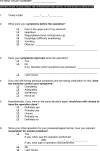Long-Term Patient-Reported Outcomes of Paraesophageal Hernia Repair
- PMID: 29162971
- PMCID: PMC5683814
- DOI: 10.4293/JSLS.2017.00052
Long-Term Patient-Reported Outcomes of Paraesophageal Hernia Repair
Abstract
Background and objectives: There is a lack of consensus on the optimal repair technique and the definition of good outcomes in paraesophageal hernia (PEH) repair. We reviewed long-term patient-reported outcomes of open and laparoscopic PEH repair to assist with our future surgical consent process.
Methods: This was a retrospective case-control study including all patients with PEH repair performed from 2000 through 2012 at a single center without the use of mesh. We mailed questionnaires to patients to assess reoperation, symptom control, and satisfaction.
Results: Chart review identified 217 patients who underwent PEH repair. Nineteen died during the follow-up period. Of the 106 returning the questionnaire, 87 underwent laparoscopic repair, and 19 had open repair, with follow-up of 6.6 (SD 3.9) years and 7.0 (SD 4.1) years, respectively. Reoperation rates were 9.9% and 5.3%, respectively (P = .720). Dysphagia, heartburn, and regurgitation improved in 95.4% of patients after laparoscopic repair and 89.5% after open repair (P = .318). Medication for symptom control was necessary in 54.0% of patients after laparoscopic repair and 26.3% after open repair (P = .029). In each group, 90% stated that they would still choose to have the operation (P = .713).
Conclusions: Long-term patient-specific outcomes showed comparable, encouraging results between open and laparoscopic repair of PEH without mesh reinforcement. However, half of those undergoing laparoscopic repair required the use of medication for symptom control. This study adds to the literature describing long-term patient-specific outcomes and can be useful when counseling patients about PEH repair.
Keywords: Cruroplasty; Hiatal hernia; Laparoscopic repair; Mesh repair; Paraesophageal hernia.
References
-
- Swanstrom LL, Marcus DR, Galloway GQ. Laparoscopic Collis gastroplasty is the treatment of choice for the shortened esophagus. Am J Surg 1996;171:477–481. - PubMed
-
- Fisichella PM, Patti MG. Laparoscopic repair of paraesophageal hiatal hernias. J Laparoendosc Adv Surg Tech A. 2008;18:629–632. - PubMed
-
- Patti MG, Fisichella PM. Laparoscopic paraesophageal hernia repair: how I do it. J Gastrointest Surg. 2009;13:1728–1732. - PubMed
MeSH terms
LinkOut - more resources
Full Text Sources
Other Literature Sources
Medical

